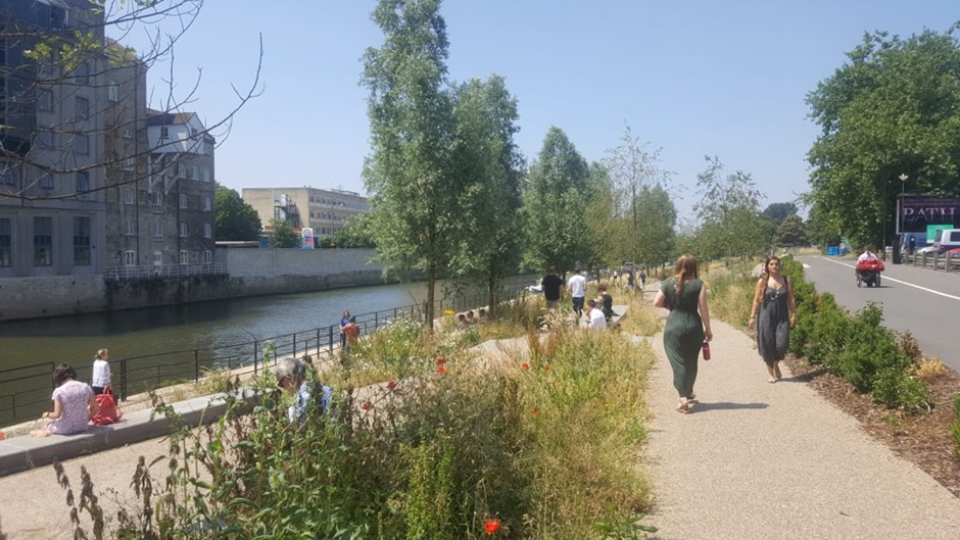
The park is located on the north riverbank between Churchill Bridge and Green Park in Bath City Centre. The site is within the Bath World Heritage Site.
The River Avon corridor is a Site of Nature Conservation Interest and is rich in biodiversity. The area has a particular interest for bats, invertebrates and slow worms and otters have also been recorded.
To create a riverside park, reconnecting the city centre to the riverside and to mitigate flooding for more than 100 existing properties.
The project was originally conceived as a flood mitigation and defense project, however it became an opportunity to re-connect the city with its previously neglected riverside.
This led to the creation of a multifunctional riverside park, acting as a green open space for the public when river is low yet is designed to accommodate flood water when the river is high. In times of flood the park is closed to the public with bollard and chains with warning signs. An information campaign and cartoon played in Universities also explains that this is a park and a flood defense, so that at certain times of year it may be closed off.
To increase the sense of place and connect people to the river, vehicles were diverted from Green Park road onto a new road and the riverbank was widened, creating a public open space. Flood tolerant wild flowers and ferns have been planted to withstand flood events. Ecological improvements included the planting of 150 trees including fruiting species to attract pollinators, reed rafts in the River Avon, sensitive riverside lighting for bats and other wildlife.
The park will form part of a larger WaterSpace project which will see the development of a 3.7 mile linear park along the River Avon. The site will be managed for the first 5 years by BaNES Council through a management plan.
|
Potential impacts/ benefits |
||||
|
Challenges addressed |
Enhancing sustainable urbanisation |
Restoring ecosystems and their functions |
Developing climate change mitigation |
Developing climate change adaptation |
|
Water Management |
·Increase population and infrastructure protected by NbS ·Increase amount of green open spaces ·Increase awareness of NbS and their effectiveness and co benefits |
·Increase quantity and quality of green and blue infrastructures |
·Flood peak reduction ·Reduce flood risk |
|
|
Climate resilience |
·Reduction of energy in the production of building materials |
·Reduce flood risk |
||
|
Green Space management and enhancing urban biodiversity |
·Increase accessibility to green open spaces ·Changing the image of the urban environment |
·Increase biodiversity |
·Reduce flood risk |
|
|
Public Health and Wellbeing |
·Increase well being ·Increase social interaction |
·Increased cultural richness and biodiversity |
||
- Flood peak reduction
- Reduce flood risk
- Reduction of energy in the production of new buildings and building materials
- Increase Biodiversity
- Increase quality and quantity of green and blue infrastructures
- Changing image of the urban environment
- Increase accessibility to green open spaces
- Increase amount of green open spaces for residents
- Increase awareness of NBS solution & their effectiveness and co benefits
- Increase population & infrastructures protected by NBS
Could be used in other cities with waterways needing to mitigate flood risk
It is possible to reconnect cities and people with nature whilst also mitigating climate change impacts.
It is good to have multifunctional Green Infrastructure; however it can add pressure for maintenance.
The total cost of the scheme was £7.22 million. The Council and Environment Agency are funding these works with a combination of Revolving Infrastructure funding made available by the West of England Local Enterprise Partnership (LEP): £6.1 million, and Local Levy: £0.510 million and Flood Defence Grant in Aid funding: £0.610 million.




